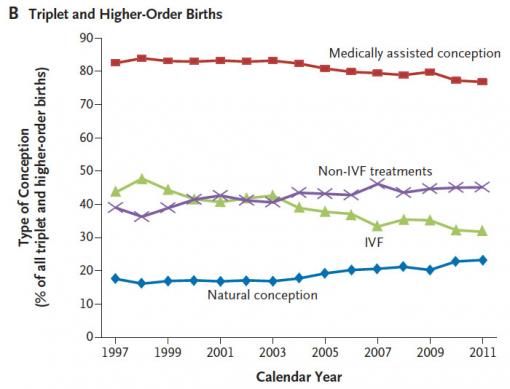More Triplet and Higher-Order Births Occurring, but Not From IVF
Fertility technology, particularly non-IVF treatments, has resulted in a marked increase in multiple births, having significant health implications for both mothers and babies.
Fertility technology has led to a marked increase in the frequency of twins, triplets and other multiple births, according to new estimates published this month in the New England Journal of Medicine.
The study, which was funded by the Centers for Disease Control and Prevention, reported that 36% of twin births and 77% of triplet and higher-order births in the United States in 2011 were the result of fertility treatments.
"We do have a real problem with way too many multiple births in the United States with consequences to both mothers and babies," said Dr. Eli Y. Adashi, professor of obstetrics and gynecology at Brown University and the study's senior author, in a statement. "It's an unintended consequence of otherwise well intentioned and remarkable technology."
The researchers looked at data on multiple births from 1962 to 1966 (before any medical fertility treatments were available) and from 1971 through 2011. The observed incidence of twin births increased by a factor of 1.9 from 1971 to 2009, the researches found, while the incidence of triplet and higher-order births increased by a factor of 6.7 from 1971 to 1998 and decreased by 29% from 1998 to 2011.

New estimates of multiple births suggest that while guidelines have reduced the percentage of medically assisted triplet or higher-order births related to IVF, non-IVF methods are increasing their share.
While the 1998 guidelines discouraging the implantation of 3 or more embryos caused a drop in the proportion of triplets or higher multiple births, from 48% to 32% between 1998 and 2011, the researchers found that non-IVF fertility treatments are causing multiple births. Specifically, the percentage of triplets or more due to non-IVF procedures rose to 45% of cases, from 36% between 1998 and 2011.
In estimating the influence of non-IVF procedures on multiple births, the researchers subtracted the multiple births arising form IVF from the overall number of multiple births. They used the data from the 1960s, before the techniques existed, as a baseline for natural multiple birth rates without medical intervention.
"IVF is moving, in a sense, in the right direction and cleaning up its act, whereas the non-IVF technologies are at a minimum holding their own and possibly getting worse," Adashi said in a statement. "From a policy point of view, what that means is that [we] need to focus on the non-IVF technologies, which really hasn't been done in a concerted way because they weren't considered all that relevant to this mix."
Pertinent Points:
- A study published this month found 36% of twin births and 77% of triplet and higher-order births in the United States in 2011 were the result of fertility treatments.
- The incidence of triplet and higher-order births decreased by 29% from 1998 to 2011.
- More multiple births are now being attributed to non-IVF fertility treatments.
References:
Reference
Kulkarni AD, Jamieson DJ, Jones HW Jr, et al. Fertility treatments and multiple births in the United States. N Engl J Med. 2013;369:2218-2225.
S1E4: Dr. Kristina Adams-Waldorf: Pandemics, pathogens and perseverance
July 16th 2020This episode of Pap Talk by Contemporary OB/GYN features an interview with Dr. Kristina Adams-Waldorf, Professor in the Department of Obstetrics and Gynecology and Adjunct Professor in Global Health at the University of Washington (UW) School of Medicine in Seattle.
Listen
Study shows a healthy prenatal diet could be upstream obesity prevention strategy
December 26th 2024"Our findings support the recommendation of a healthy diet based on the current guidelines (as measured by the HEI) during pregnancy, since it may reduce patterns of infant growth outside reference ranges."
Read More
Early pregnancy cannabis use high in states with recreational legalization
November 11th 2024A population-based time-series analysis California before, during and after legalization show a rising trend in women using cannabis while pregnancy especially when the state has legalized the drug.
Read More
